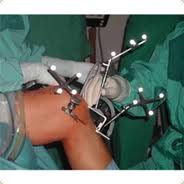 Computer-Assisted Surgery Not More Precise? (Orthopedics This Week)
Computer-Assisted Surgery Not More Precise? (Orthopedics This Week)
Duncan Meuffels M.D., Ph.D. is an orthopedic surgeon at the University Medical Centre Rotterdam in The Netherlands. Even he was surprised by the findings of his recent study, “Computer-Assisted Surgery [CAS] is not more accurate or precise than conventional arthroscopic ACL reconstruction: a prospective randomized clinical trial.” Asked what led him to select this topic for study, Dr. Meuffels told OTW, “In my sports medicine practice I treat many patients with anterior cruciate ligament [ACL] injuries, who in general can return to their original sport. There are however, some patients who do less well and are not as satisfied with their reconstruction. The literature shows that mal-positioning of the new ACL graft is the reason for failure after an ACL reconstruction in 4 out 5 cases. I had already used computer-assisted surgery for some time for total knee replacement and had seen its potential in neurosurgery. Computer-assisted surgery gives the surgeon an extra feedback and could have additional value in choosing the right tunnel position for the ACL graft. The possibility to template before you actually position the new ACL graft and to verify the actual creating and positioning of the ACL, has great potential. It was also a good teaching tool for me and for the orthopedic surgeons I train.”
“It was a surprise and maybe even a little disappointing at first to find out with our three dimensional CT data that our actual positioning was no more accurate or precise than without the CAS. We used a CAS system that intra-operatively references to X-rays taken of the knee at the beginning of the surgery. It is possible that the acquiring or processing of the information is not fully reproducible. The templating is done on an X-ray image which is a two dimensional estimate in percentages of the size of the femur and tibia of what an ideal positioning would be. There is a lot of anatomical variance between every individual. The chosen position is an average of this variance and should possibly be tailored more to each and every individual. During surgery we already take a lot of different variables in consideration including the size of the femur and tibia, the intercondylar size and shape, the graft size, the position of the posterior cruciate ligament and the lateral meniscus. And dynamically we check for anterior impingement on the intercondylar notch. Possible adding more information with the CAS system does not improve positioning.”
“This study does not give the average orthopedic surgeon a reason to change to CAS ACL surgery or to add CAS ACL surgery to his repertoire. We have had a lot of positive response, congratulating us on a very honest and methodologically sound clinical trial. A number of surgeons are very interested in using our measuring skills to look at three dimensional positioning of the ACL tunnel and are asking us for our expertise. The orthopedic world should also be aware that there is a possible difference in what we see and what we actually do during surgery, especially arthroscopic surgery. Arthroscopic surgery and computer-assisted surgery have immense possibilities to enlarge what we see and give us a sense of accuracy and precision. We should, however, not stop checking our results and also keep a wider vision.”

 Tiger Buford – retained recruiter dissecting orthopedics
Tiger Buford – retained recruiter dissecting orthopedics